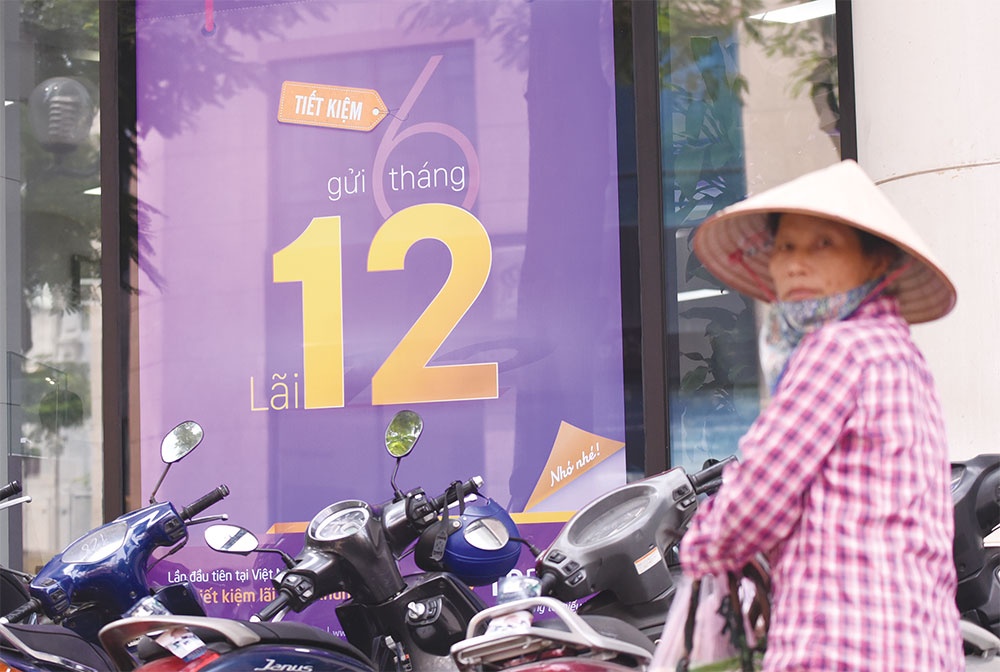Wise roadmap key for rate softening
 |
| Some banks have scaled down their online interest rates for 12-month terms |
At a conference on credit channels to the real estate segment hosted by the State Bank of Vietnam (SBV) on February 8, Vietcombank CEO Nguyen Thanh Tung said that prior to the conference, top banking leaders had reached consensus about taking joint measures towards consecutively soothing the deposit rate and then the lending rate to aid both businesses and market development.
In January, the interest rate in the market had softened from 0.6 to 0.2 per cent annually at several lenders with comparatively high interest rate records such as SCB, Techcombank, HDBank, and OCB, mainly tailored to a 6-month term and beyond.
Other banks like ACB and SHB have also trimmed their ceiling rates applicable to specific packages to 9 per cent per year, while OCB and MSB scaled down their online interest rate for 12-month terms to 8.8-9 per cent per year.
In general, the deposit rates at non-state banks are kept from 0.4 to 2.3 per cent higher than those at state lenders, depending on the term.
One leader from BIDV told VIR that liquidity has become less abundant, particularly driven by a spike in cash payments on a periodical basis.
“The deposit-credit balance has been shrunken amid mobilising distress, with the deposit growth about 0.5 per cent lower than the credit growth,” said the executive.
According to the leader, bank liquidity in January was low in intensity thanks to several factors. Firstly, the SBV’s monetary policy continues to shift towards aiding liquidity and the economy, through increasing money injection via the open market.
“Secondly, foreign currency supply shifts in a more favourable direction, facilitating the SBV to buy foreign currencies in large volumes, contributing to supplementing VND cash flow for liquidity and improving market sentiment,” he added. “Also, cash flow stagnation in the deposit channel of the State Treasury is somewhat reduced when part of 2022 public investment capital was paid and completed in January.”
In February, the VND-denominated interest rate has witnessed a continuing downward trend at some commercial banks in the context that the central bank’s monetary policy is expected to remain stable to support the economy. Domestic economic growth, however, is still encountering hardship but inflation is expected to ease in the forthcoming months.
The VND liquidity of the banking system is also improving thanks to huge cash amounts circulating back into the system after Lunar New Year.
Economist Nguyen Tri Hieu noted that an interest rate reduction is a wise move in current context, but caution is a must to avoid negative economic consequences.
“Lowering the deposit interest rate means that people’s deposits at banks are no longer attractive. With an inflation forecast of about 4 per cent this year, it is necessary to ensure stable deposit rate so that people have confidence and peace of mind to deposit at banks,” Hieu said.
The general director of one joint-stock lender commented that along with lowering the deposit rate to retain customers, banks have to consider the introduction of incentives to attract depositors, which would cause a significant expense. “Without offering an attractive deposit rate, there will not be much money to lend out, the money supply will be narrowed, and the risk associated with foreign currency deposits as seen in 2022 may return,” said the director.
Securities expert Dao Phuc Tuong added, “The SBV must balance between the three objectives of controlling inflation, stabilising exchange rates, and supporting economic growth. While inflation has shown signs of decreasing, many risks persist. In addition, the SBV also needs to replenish foreign exchange reserves after selling foreign currencies to intervene in the market in the first half of 2022.”
With the expectation that the US Federal Reserve is to continue to raise operating interest rates up to 5 per cent in the near future, it will narrow the VND-USD interest rate gap. “I don’t think there is much room for the SBV to further decrease the operating interest rate,” Tuong said.
“If the US and European economies don’t have a soft landing as expected, and the flow of indirect investment turns back, the SBV would have to sell foreign currency to intervene in the exchange rate. Then, if interest rates have been lowered, the SBV may need to raise the interest rate again, causing policy instability,” Tuong added.
 | High interest rates compound business woes Businesses face mounting hardships due to the spike in interest rates, leading to shrinking results and significantly diminished production, as banks are called upon to show more sympathy to businesses. |
 | Interest rate pressures to remain for the foreseeable High interest rates are causing major issues for businesses, hindering cash flow for production and investment. |
What the stars mean:
★ Poor ★ ★ Promising ★★★ Good ★★★★ Very good ★★★★★ Exceptional
Related Contents
Latest News
More News
- Miza Nghi Son green bond marks milestone for sustainable finance (January 19, 2026 | 09:51)
- Higher 2026 growth target puts pressure on credit framework (January 19, 2026 | 09:00)
- VN-Index could reach 2,040 points in 2026 (January 16, 2026 | 16:41)
- Vietnam’s corporate bond market set for a more positive 2026 (January 15, 2026 | 14:10)
- Foreign sentiment towards Vietnam turns more positive (January 15, 2026 | 11:08)
- Wealth management faces skills gap as investor confidence lags (January 13, 2026 | 10:23)
- HDBank completes $100 million international green bond scheme (January 12, 2026 | 16:28)
- Vietnam’s IPO market eyes revival in 2026 (January 09, 2026 | 17:28)
- Brokerage competition tightens as market shares narrow (January 09, 2026 | 15:19)
- Banks set for selective hiring in 2026 (January 08, 2026 | 10:56)

 Tag:
Tag:




















 Mobile Version
Mobile Version